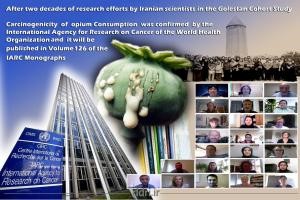After two decades of research efforts by Iranian scientists in the Golestan Cohort Study
Carcinogenicity of Opium Consumption was confirmed by the International Agency for Research on Cancer

At an important historical event , Carcinogenicity of Opium Consumption , the most prominent achievement of more than two decades of research efforts of Iranian scientists in the "Golestan Cohort Study " was published in Volume 126 of the Monographs of the International Agency for Research on Cancer of the World Health Organization (IARC)
Writer: Fereshteh Hashemi
According to the Digestive Diseases Research Institute (DDRI) of Tehran University of Medical Sciences (TUMS) Carcinogenicity of Opium Consumption in humans was evaluated during the 126th series of the Monographs meetings held virtually from 11-20 September 2020 by IARC (due to The COVID-19 pandemic) with the participation of 16 expert scientists from 10 countries around the world. The results of these assessments were published October 8, 2020 in the Lancet Oncology.
Classification of carcinogens in humans
The IARC Monographs identify environmental factors that have carcinogenic hazards to humans. These include chemicals, complex mixtures, occupational exposures, physical agents, biological agents, and lifestyle factors.
Since 1971, more than 1000 agents have been evaluated, of which more than 400 have been identified as Carcinogenic (Group 1) , Probably Carcinogenic (Group2A) ,Possibly Carcinogenic (Group 2B) and Non Classiffiable (Group3) to humans.
Classification of Opium Consumption as a Carcinogen
The working group of international experts that participated in the volume 126 of the IARC’S Monographs program, spent more than 17 months in reviewing in details all evidence on the carcinogenicity of opium consumption and then in 10 days discussed all the available evidence that originated from human studies and the mechanistic studies which are included :
-Opium Consumption is Carcinogenic to humans (Group1). The Group1 evaluation is based on sufficient evidence of cancer in human studies. This sufficient evidence determination applies to smoked and ingested routes of raw, dross, and sap opium consumption.
-Evidence in humans was sufficient for cancers of bladder, larynx, and lung.
-Evidence in humans was association for cancers of oesophagus, stomach, pancreas, and pharynx.
-There is strong evidence in experimental systems that opium (sukteh & opium pyrolysates) exhibits key characteristics of carcinogenicity (opium is genotoxic).
Opium Consumption is Carcinogenic to humans
According to the International Agency for Research on Cancer (IARC) there is sufficient evidence in humans for the carcinogenicity of opium consumption and this “sufficient” evidence determination applies to smoked and ingested routes of raw, dross, and sap opium consumption. Therefore, Opium Consumption is Carcinogenic to humans.
The main evidences of opium monograph were from Golestan Cohort Study
Two cohort studies and more than two dozen case-control studies (most hospital-based) carried out across diverse regions and populations of Iran have investigated the association between opium consumption and incident cancers of various sites but the most informative was the Golestan Cohort Study (GCS).
During more than two decades of research efforts, the Golestan Cohort Study has made significant and unique contributions to the identification of causes of cancer and non-communicable diseases including cardiovascular and cerebrovascular diseases which led to the reception of the IARC Medal of Honor by the founder and principal investigator of the Golestan Cohort Study, Profesor Reza Malekzadeh, in 2018.
According to the Digestive Diseases Research Institute (DDRI) of Tehran University of Medical Sciences (TUMS) the detailed assessment of demographic, socioeconomic, and lifestyle factors addressed concerns regarding major potential confounders, including tobacco smoking. Several unrelated case-control studies also used the GCS questionnaire, while others used different questionnaires, interviews, or patient records to evaluate opium exposure. The amount of detail and quality of exposure information varied considerably across the epidemiological studies.
While individually each study has its limitations, the Working Group concluded that collectively these studies provide a basis to rule out chance, bias, and confounding as alternative explanations for the positive association between opium use and cancers of bladder, larynx, and lung with reasonable certainty; thus, there was suffficient evidence of human arcinogenicity for these three cancer types. Additionally, evidence was deemed to be limited that opium consumption causes cancers of oesophagus, stomach, pancreas, and pharynx.
According to the International Agency for Research on Cancer of the World Health Organization (IARC / WHO) ,in human opium metabolites have been detected in urine, hair, and blood following ingestion or smoking of opium. there was strong evidence in experimental systems that opium, specifically sukhteh and opium pyrolysates, exhibits key characteristics of carcinogens .These opium metabolites are genotoxic.
comment